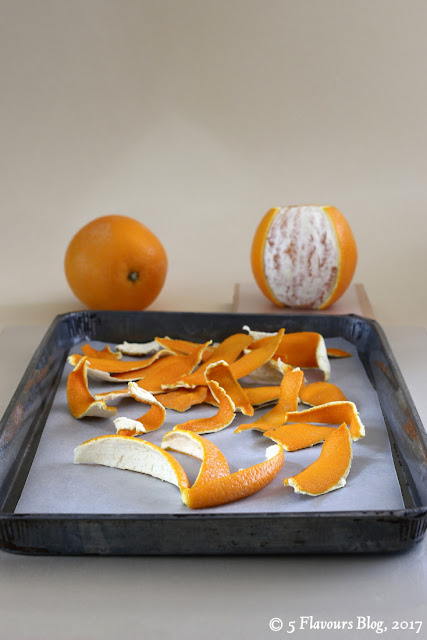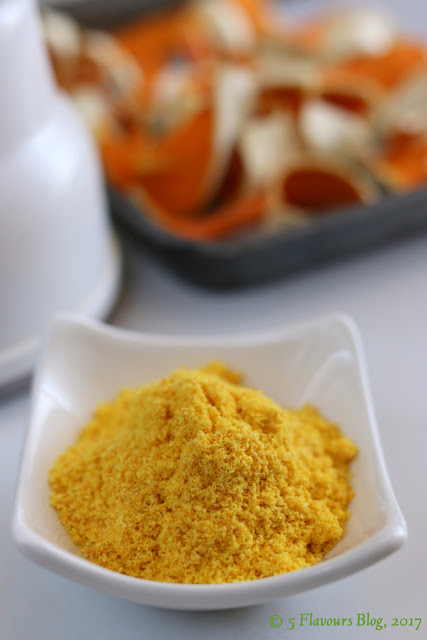Orange Peel Powder
The
above, however, is not the full picture. I’ve been racking my brains to come up
with a clear description of the flavour that ground orange peel imparts to
savoury dishes and baked goods – and why to use it in preference to grated, fresh
orange peel. The best rationale I’ve
been able to assemble, boils down to the following:
- Dried orange peel imparts an honest and rustic flavour that is deeply concentrated, somewhat austere, yet surprisingly gentle despite it’s insistent pervasiveness.
- Occasionally it becomes preferable to avoid the bright, often too keen vivaciousness of fresh orange peel that is so perfectly suited to Osso bucco ala Milanese and Crepes Suzette, but not to a meltingly tender, long-baked oxtail stew or as support for smoked chicken breast slices in a lively salad with rockett, feta and sundried tomato preserved in olive oil. Every once in a while, less – in reality – becomes more.
The
home production of this wondrous capriciousness is surprisingly simple.
Carefully peel a navel orange into segments roughly one finger wide. Lay them
out, skin side up, in a single layer on waxed paper. Eat the peeled orange.
Leave the peels for two days or so in a quiet, warm spot. Collect the dried
peels in a jar. Eat some more oranges and dry the peels as before. Break the
peel into shards when you collected the dried peels of 5 – 6 oranges. Grind to
a fine powder in a blade type coffee grinder. Use the end product wherever your
bold fancy may take you.
One
caveat: add the ground orange peel to
stews, casseroles or crock pots towards the end (say the last third) of the
cooking period. The lovely rusticity of the orange flavour is not heat stable
and will fairly rapidly disappear if used too soon in a slow cooked savoury
dish.
The
range of applications for ground, dried orange peel is quite wide and – as
usual – only limited by the imagination and audacity of the cook. Some common
applications include:
- In oil based marinades – particularly for chicken & fish. The essential oil in orange peel is preferentially oil soluble as compared to water or acid based marinades.
- As infusions – add a dash to black or green teas, steep and enjoy; combine it with extra virgin olive oil meant for salad dressings and leave aside for 2 – 3 weeks to infuse.
- In flavoured salt – combine it with rosemary, thyme and coarse Atlantic sea salt in a burr type grinder. Try it over scrambled eggs on good white bread toast.
- In meat glazes – add a citrusy, fruity element to sticky, roasted chicken wings.
- Baked goods – particularly where the orange flavour needs to be supportive and understated (see the Chelsea Buns recipe coming soon) or to round out the flavour of fresh orange peel as in Orange Syrup & Kumquat Ring Cake.
- Beauty products – Google has a lot of advice for the ladies on the use of dried orange peel in face masks, defoliants and related applications.
- Potpourri – grind the dried peel only partially and add it to your favourite mix of potpourri ingredients to keep linens and such smelling of summer and sun filled glades with babbling brooks.
Recipe yields:
± 50 Gram
|
Preparation time:
3 – 4 Days
|
Processing time:
15 min
|
Difficulty level:
Easy peasy!
|
Special Equipment Required:
1
x Electrical coffee grinder, blade type.
Ingredients:
Peel from navel oranges
|
5
|
Corn flour
|
2.5ml
|
Method:
- Wash the navel oranges with warm soapy water to remove the outer wax layer. Rinse well and dry. Simply wipe with a clean, moist cloth if using organically produced oranges.
- Carefully peel the oranges into segments roughly one finger wide. Avoid including some of the fruit cells onto the white pith section.
- Lay the peel wedges, skin side up, in a single layer on waxed paper. Leave the peels for two days or so in a quiet, warm spot.
- Collect the dried peels and break them into shards. Using short pulses (to avoid burning out the grinder motor), grind batch wise to a fine powder in a blade type coffee grinder. Use a fine sieve to sift the ground peel from the grinder when it appears to be done. Return any residue to the grinder along with the new batch of broken peel. Repeat until all the peel is ground.
- Add the corn flour to the ground peel, mix thoroughly, transfer to a sealable container and store in the deep freeze for maximum, extended freshness.
Comments:
- If experiencing rainy or cold weather, dry the peels in a stove’s warming drawer or an oven at it’s lowest setting. If drying by oven, check the peel every 30 minutes. Remove the peel when dry and brittle before it becomes discolored. Heat, oxygen and residual moisture are the enemies of the essential oils in the dried peel. Avoid exposing the dried peel to excessive quantities of heat and oxygen.
- Use a moist cloth to wipe out the grinder’s interior chamber after use. Beware the blade.
- Grind an equal measure of uncooked rice and white sugar in the grinder if any orange aroma remains after cleaning.
- Do not use a burr (or opposing roller) type coffee grinder to prepare the powder. Your Wiener Mischung and Italian blends will forever after have an undertone of orange that may take a while to get used to.
- Corn flour is added to prevent the ground orange peel from clumping on storage and to collect any residual moisture.
© RS Young, 2017
– RECIPE INDEX PAGE –
Follow Me on Facebook
Note:
Post
updated on 2024.03.18 to include:
1.
The updated Recipe for downloading as a PDF file, and
2.
Recipe Title and Print Recipe, Recipe Index and Facebook & Pinterest follow
links.







Fantastic Post! Lot of information is helpful in some or the other way. Keep updating.bulk orange peel powder
ReplyDelete